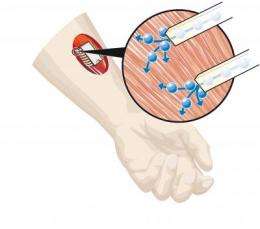The first chemical circuit developed

Klas Tybrandt, doctoral student in organic electronics at Linkoping University, Sweden, has developed an integrated chemical chip. The results have just been published in Nature Communications.
The Organic Electronics research group at Linköping University previously developed ion transistors for transport of both positive and negative ions, as well as biomolecules. Tybrandt has now succeeded in combining both transistor types into complementary circuits, in a similar way to traditional silicon-based electronics.
An advantage of chemical circuits is that the charge carrier consists of chemical substances with various functions. This means that we now have new opportunities to control and regulate the signal paths of cells in the human body.
"We can, for example, send out signals to muscle synapses where the signalling system may not work for some reason. We know our chip works with common signalling substances, for example acetylcholine," says Magnus Berggren, Professor of Organic Electronics and leader of the research group.
The development of ion transistors, which can control and transport ions and charged biomolecules, was begun three years ago by Tybrandt and Berggren, respectively a doctoral student and professor in Organic Electronics at the Department of Science and Technology at Linköping University. The transistors were then used by researchers at Karolinska Institutet to control the delivery of the signalling substance acetylcholine to individual cells. The results were published in the well-known interdisciplinary journal PNAS.
In conjunction with Robert Forchheimer, Professor of Information Coding at LiU, Tybrandt has now taken the next step by developing chemical chips that also contain logic gates, such as NAND gates that allow for the construction of all logical functions.
His breakthrough creates the basis for an entirely new circuit technology based on ions and molecules instead of electrons and holes.
Journal information: Nature Communications , Proceedings of the National Academy of Sciences
Provided by Linköping University


















